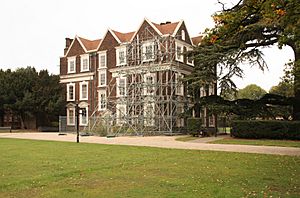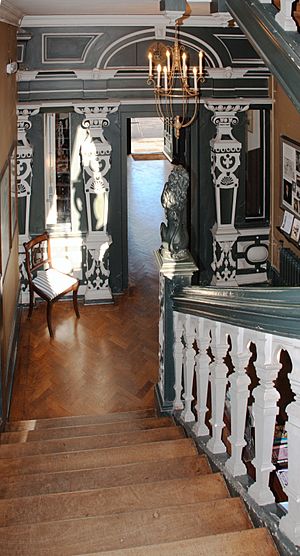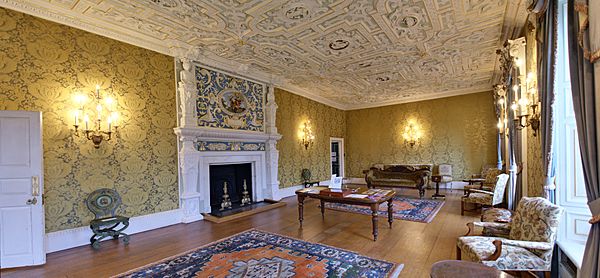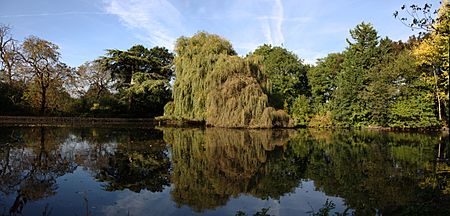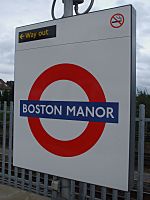Boston Manor House facts for kids
Quick facts for kids Boston Manor House |
|
|---|---|

Front view of Boston Manor House
|
|
| Type | Manor house |
| Location | Brentford |
| OS grid reference | TQ 16839 78339 |
| Area | Greater London |
| Built | 1622 |
| Architectural style(s) | Jacobean |
| Owner | London Borough of Hounslow |
|
Listed Building – Grade I
|
|
| Official name: Boston Manor House, Boston Manor Park | |
| Designated | 11 July 1951 |
| Reference no. | 1079603 |
| Lua error in Module:Location_map at line 420: attempt to index field 'wikibase' (a nil value). | |
Boston Manor House is a beautiful old house built in 1622. It's a great example of Jacobean architecture, which was popular when King James I was on the throne. This house was once the main home for a large estate called a "manor."
Today, Boston Manor House is in west London, within the London Borough of Hounslow. Next to it is Boston Manor Park, a lovely green space with a lake that's open to everyone.
Contents
Exploring Boston Manor's Past
How Boston Manor Got Its Name
The area of Boston was first mentioned around the 1170s. Back then, it was called "Bordwadestone." The "stone" part means "farmstead," and "Bordwad" was likely a person's name. So, it was "Bord's farmstead."
The first owner of the land, known as the Lord of the manor, was Ralph de Brito. He built a small church, and the boundaries of this church area became the same as the manor's boundaries.
From Royal Hands to Private Owners
Around 1280, King Edward I gave this land to a group of nuns at St Helen's Bishopsgate convent. This made Boston a recognized village. The King did this to make it easier to collect taxes.
In 1539, King Henry VIII closed down many convents and monasteries, including St Helen's. So, Boston Manor returned to the Crown.
The land then passed through the hands of several important people:
- Edward Seymour, 1st Duke of Somerset, during King Edward VI's reign.
- After the Duke was executed, Queen Mary I took the land back.
- Queen Elizabeth I gave it to her favorite, Robert Dudley, 1st Earl of Leicester.
- Robert Dudley quickly sold it to Sir Thomas Gresham, a very rich merchant who also founded the Royal Exchange.
The Clitherow Family and the House's Construction
Sir Thomas Gresham didn't have children, so the property went to his stepson, Sir William Reade. After Sir William died, his wife, Mary Goldsmith, built Boston Manor House in 1622–1623.
She later married Sir Edward Spencer. After Mary died in 1658, the land went to her heir, John Goldsmith. In 1670, John's family sold Boston Manor to a very wealthy merchant named James Clitherow I. He paid a lot of money for the house and its 230 acres of land.
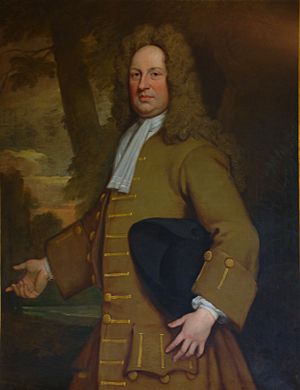
An early owner of Boston Manor House
The Clitherow family owned Boston Manor for about 250 years. Over time, parts of the estate were sold off as the nearby town of Brentford grew.
Boston Manor Becomes a Public Park
The last private owner was John Bourchier Stracey-Clitherow. In 1923, he sold the house and its remaining 20 acres to the Brentford Urban District Council. The house and park were then opened to the public in 1924.
Boston Manor Park has won the Green Flag Award many times, which means it's one of the best green spaces in England and Wales.
Boston Manor House: A Closer Look
The House's Story
Boston Manor House was built for Dame Mary Reade in 1622-1623. The Clitherow family later added parts to the north of the house, including kitchens and staff rooms.
The house was badly damaged during World War II by a V1 flying bomb. For a while, it was even used as a school! After a lot of repair work, it was reopened in 1963 by Queen Elizabeth The Queen Mother. It became a visitor center and museum.
Because of its unique old style, the house has often been used as a setting for movies that take place in the past.
At one point, a corner of the house needed urgent repairs to its foundations. You could even see a crack running up the wall! Luckily, it has since been fixed.
A group called the Friends of Boston Manor helps to look after and restore the house and park. After six years of renovation, the house reopened to visitors on July 7, 2023.
What the House Looks Like Inside and Out
Boston Manor House is a "Grade I listed building," which means it's very important historically. It's made of thick red bricks and has three floors. The windows have stone frames, and there's a stone border between the second and third floors.
You'll notice three pointed gables on the longer sides of the house and two on the shorter sides. The metal pipes that collect rainwater from the roof have dates stamped on them. The ones on the original part of the house say 1662, which is when building started. Another says 1670, when a third gable was added, and 1915, when drainage was improved.
The main entrance to the house is through a porch on the east side. This porch was added later and is made of light-colored stone. It looks like it might have come from another old building!
Inside, you enter a large hall. To your left is the dining room, which is painted a bright yellow. It has paintings of local scenes from long ago.
Further into the hall, on the left, is the library. This room is currently locked to visitors because of the wall's condition.
One of the most special parts of the house is the original Jacobean staircase. The steps are not as steep as modern stairs, making them easier to climb. The staircase has beautifully carved oak posts and railings. On the opposite side of the stairs, there's a painted railing that looks real but isn't! This special painting technique, called "Trompe d'œil," is very rare for this time in England.
At the top of the staircase posts, you'll see small lion statues. Each lion holds a shield with the symbol of a different Clitherow family member. These might have been added for a visit from King William IV and Queen Adelaide.
From the landings of the stairs, you get a great view of the garden and its old cedar trees, which were planted in 1754.
It's said that the ghost of young John Clitherow, who sadly drowned, still lives in the house.
On the second floor, you'll find the state bedroom. It has an amazing plaster ceiling with detailed designs. One part shows a female figure representing "Hope."
Next to this is the famous state drawing room. This is where the ladies would go after dinner. It's a large room with a magnificent Jacobean ceiling. Some parts of the design were created by a Dutch artist named Marcus Gheeraerts the Younger. In one corner, you can see the building date, and in another, Mary Reade's initials. The fireplace also has a very detailed carving.
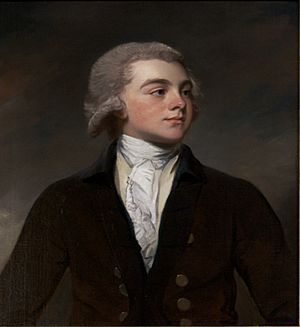
On the wall of the top flight of stairs, you can see some old wallpaper from the 1700s. It's a bit worn, but it's one of the best examples of its kind that still exists today.
Over the years, the Clitherow family updated the house. They replaced the original windows with modern ones and added panels to keep in the heat. They also installed central heating and gas for the kitchens.
Many of the beautiful pieces of furniture in the house have been loaned from the Gunnersbury Park Museum. The house also has a collection of paintings, including portraits of the Clitherow family.
Boston Manor Park: Fun for Everyone
The park is free to enter and open every day from 8 AM until dusk. It has:
- A modern playground for children.
- Three tennis courts.
- A basketball court.
- A cafeteria run by volunteers on weekends.
- A Nature Trail to explore.
- Formal lawns and a beautiful ornamental lake with wild birds.
You can also find "car boot sales" (like a big outdoor garage sale) held here on the first Saturday of every month.
Nearby Historic Places
Boston Manor House is surrounded by other interesting historic sites:
- Southall Manor House (about 3.7 miles away)
- Pitzhanger Manor House & Gallery (about 2.3 miles away)
- Gunnersbury Park Museum (about 2.6 miles away)
- Osterley Park House (about 2.8 miles away)
- Chiswick House (about 3.4 miles away)
- Syon House (about 2.3 miles away)
- Kew Palace (about 3 miles away)
- Ham House (about 6.8 miles away)
Getting There
You can reach Boston Manor House by bus 195 or E8. The closest London Underground station is Boston Manor, which is on the Piccadilly line.
The M4 motorway overpass goes through Boston Manor Park.


